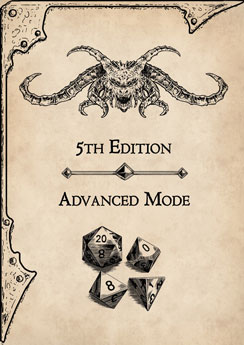Huge beast (dinosaur), unaligned
Armor Class 13 (Natural Armor)
Hit Points 136 (13d12+52)
Hit Points (suggested)189 (18d12+72)
Speed 50 ft.
Proficiency Bonus +3
Proficiency Bonus +6 (5th Edition Advanced Mode)
| STR | DEX | CON | INT | WIS | CHA |
|---|---|---|---|---|---|
| 25 (+7) | 10 (+0) | 19 (+4) | 2 (-4) | 12 (+1) | 9 (-1) |
Skills Perception +4
Senses passive Perception 14
Challenge 8 (3,900 XP)
Keen Smell (suggested). The tyrannosaurus rex has advantage on Wisdom (Perception) checks that rely on smell.
Swallow Whole (suggested). If the tyrannosaurus bite a restrained target of Medium or smaller size, then it swallos the target. A swallowed target suffer the paralyzed condition and takes 29 (5d8 + 7) bludgeoning damage in the first round, and 26 (5d8 + 4) acid damage for the subsequent rounds.
ACTIONS
- Multiattack (suggested). The tyrannosaurus makes four attacks attacks, one with its bite, one with its tail and two with its claws. It can’t make a bite and a tail attack against the same target.
- Bite. Melee Weapon Attack: +10 to hit, reach 10 ft., one target. Hit: 33 (4d12 + 7) piercing damage. If the target is a Medium or smaller creature, it is grappled (escape DC 17). Until this grapple ends, the target is restrained, and the tyrannosaurus can’t bite another target.
- Claw (suggested). Melee Weapon Attack: +10 to hit, reach 0 ft., one target. Hit: 10 (1d6 + 7) bludgeoning damage.
- Bite (suggested). Melee Weapon Attack: +10 to hit, reach 10 ft., one target. Hit: 33 (4d12 + 7) piercing damage. If the target is a Medium or smaller creature, it is grappled (escape DC 17). Until this grapple ends, the target is restrained, and the tyrannosaurus can’t bite another target.
- Tail. Melee Weapon Attack: +10 to hit, reach 10 ft., one target. Hit: (3d8 + 7) bludgeoning damage.
5th Edition Advanced Mode
Limiting the power of a character and making the overall difficulty of the game harder, does not reduce the creativity, indeed it does quite the opposite.
The Game Master has the option to use any and all of the instances proposed in this guide, or just some of them according to their preference.
It is the lack of something that move and motivate characters, not the abundance of it
DESCRIPTION
The Tyrannosaurus Rex is a colossal dinosaur that terrorizes all other creatures in its territory. It has a massive head with a powerful jaw full of curved teeth, capable of crushing bones and tearing flesh. Its body is covered with scaly skin, ranging from brown to green in color. It has two short arms with clawed fingers, and two long legs with three-toed feet. Its tail is thick and muscular, used for balance and as a weapon. The Tyrannosaurus Rex can grow up to 40 feet long and weigh up to 14,000 pounds.
COMBAT
The Tyrannosaurus Rex is a fearsome predator that relies on its speed, strength, and senses to hunt down its prey. It can run up to 25 miles per hour, and can detect movement and smell from far away. It prefers to ambush its prey, using its bite and tail attacks to inflict massive damage. It can also swallow smaller creatures whole, or grapple them with its jaws and shake them until they die. The Tyrannosaurus Rex is not very intelligent, but it is cunning and territorial. It will not hesitate to attack anything that enters its domain, or that poses a threat to its food or offspring.
HABITAT / SOCIETY
The Tyrannosaurus Rex lives in warm and temperate regions, such as grasslands, forests, jungles, and swamps. It is a solitary creature, except during the mating season, when it will seek out a partner of the opposite sex. The female Tyrannosaurus Rex will lay a clutch of eggs in a hidden nest, and guard them until they hatch. The hatchlings will stay with their mother for a few months, learning how to hunt and survive, before leaving to find their own territory. The Tyrannosaurus Rex has few natural enemies, except for other large predators or adventurers who dare to challenge it.
ECOLOGY
The Tyrannosaurus Rex is an apex predator that plays an important role in the ecosystem. It feeds on a variety of animals, from deer and horses to elephants and dragons. It can consume up to 500 pounds of meat in one meal, and will often leave behind carcasses that provide food for scavengers and decomposers. The Tyrannosaurus Rex also helps regulate the population of herbivores, preventing them from overgrazing and destroying the vegetation. The Tyrannosaurus Rex is revered by some cultures as a symbol of power and might, while feared by others as a menace and a curse.
